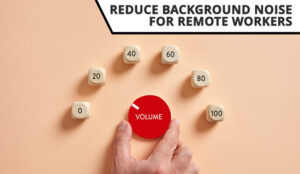In today’s fast-paced contact centre environment, effective communication is crucial for delivering excellent customer service.
However, background noise remains a significant challenge, often leading to distractions and misunderstandings during phone calls.
By implementing techniques to reduce background noise during calls, contact centres can enhance the quality of interactions, boost advisor productivity, and ultimately improve customer satisfaction.
This article explores various strategies to reduce background noise in contact centres, focusing specifically on creating a quieter and more efficient environment for conversations.
Why is Reducing Background Noise Important?
Background noise is still a big problem for many contact centres. Research shows that almost two-thirds (65.9%) of them are affected by noise, which leads to advisors repeating conversations.
The chart below highlights that while noise is mainly an issue during busy call times and shift changes, 10.3% of contact centres struggle with noise all the time, making their environments “very noisy.”
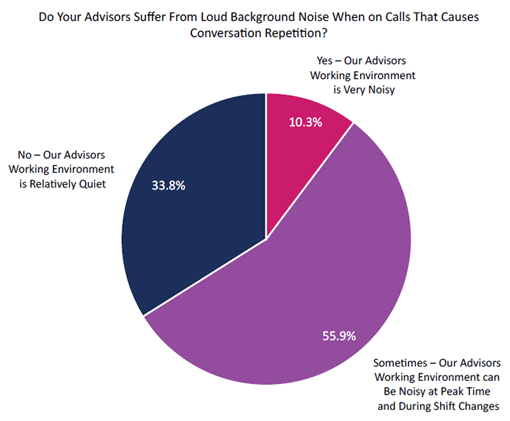
This background noise can distract advisors, making their jobs harder and impacting the experience for customers. When it’s noisy, it’s difficult for both the advisor and the customer to communicate clearly, which can create stress for everyone involved.
On a positive note, 33.8% of contact centres report having a “relatively quiet” work environment.
Working in a quiet environment, with good acoustics, offers numerous benefits, including:
- Better staff retention
- Improved productivity
- Lower stress
- Reduced absenteeism
- Increased call quality
- Lower errors
- Reduced misunderstandings
- Improved customer satisfaction
11 Ways to Reduce Background Noise in a Call Centre
To help you reduce background noise in your contact centre, we have put together a few effective strategies to help create a quieter environment.
1. Apply the ABC of Acoustics
The ABC of acoustics is an acronym that stands for Absorb, Block, and Cover, and when applied it works to absorb noise close to the source, block the direct path of sound, and cover or mask unwanted sounds.
This ABC philosophy was once taught to us by Colin Rawlings, the Technical Director of Acoustics By Design, during our webinar: “How to Reduce Background Noise in the Contact Centre“.
But how can you practically apply this thinking to a traditional contact centre?
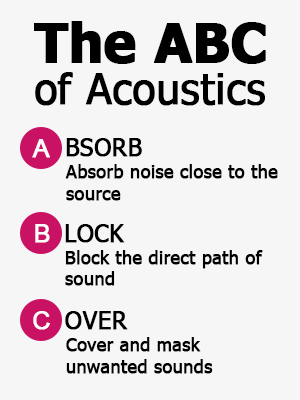
A – Absorb
To absorb sound, we can dissipate it. This may mean spacing people out in an enormous room or, more practically, absorbing it with soft materials.
While this initially wouldn’t sound highly effective, you can invest in ceiling tiles that absorb sounds instead of reflecting them.
Then there is the matter of carpets and walls, for the latter of which you can use resorb wall panels. These are covered with fabric, with a special foam layer behind them. The fabric allows the sound to travel through it, while the foam absorbs the waves from behind.
B – Block
or most, when we think about blocking, our mind goes straight to those ugly screens that “border up” desks. There is no doubt that these can make a big difference as to how far sound travels across the room – but there are other ways to block noise.
For example, you can angle an advisor’s desk so they are not directly facing another advisor and therefore cause less of a distraction.
A more obvious alternative is to choose a headset that covers both ears. Advisors won’t necessarily mind this, as long as the headset is lightweight and, preferably, cordless.
C – Cover
To cover sound, we can mask it with “white noise” and this, in a contact centres, will likely consist of a set of speakers that emit a noise similar to a rush of air.
Normally these speakers are stationed above the contact centre, as part of the ceiling, so they are tucked away and hidden.
These white noise machines will generate a background sound of normally around 42-50 decibels and most people won’t even know that they are there, unless they see you install them!
D – Discipline
Alongside our ABC “formula”, we can add a “D” for Discipline.
In contact centres, it can be commonplace to hear advisors shouting across to supervisors or maybe even vice versa. We should remind ourselves of the negative influence this has on call quality.
Some contact centres may even show people from other departments or new recruits around the contact centre and have a conversation next to someone taking a call. That not only adds to the background noise, but can be very irritating for the advisor on the phone.
There also can be other loud sounds like the “sales bell” or some sort of claxon for winning a prize. This can be great for a bit of motivation – but maybe let’s avoid setting this off during peak periods of the day.
You can find other ideas for motivating advisors, aside from sales bells and claxons, in our article: How to Motivate Staff in 25 Ways
2. Use Noise-Cancelling Headsets
Using noise-cancelling headsets is a great way to reduce background noise and improve call quality in contact centres.
These headsets effectively block out distracting sounds, allowing advisors to focus better on their conversations.
The special microphones are designed to pick up the advisor’s voice while filtering out surrounding noise, ensuring clearer communication.
When choosing headsets, consider options that provide both comfort and excellent sound quality. Additionally, training staff on how to use the headsets properly can maximize their benefits.
If you are considering which headsets to use in your contact centre operation read our article: Binaural vs Monaural Headsets in the Contact Centre
Do Noise-Cancelling Headsets Work?
The short answer to this question is “yes”. But many of the noise-cancelling headsets that are commercially available won’t work in the contact centre.
To understand this, we need to understand the two key aspects of noise cancelling. One is the ability of the headset to block out the noise of the surroundings.
The second noise-cancellation technique is where the headset produces a counter-wave to act as a “sound eraser”. This process is called “destructive interference” and visual demonstration of how this works is shown in the graph below.
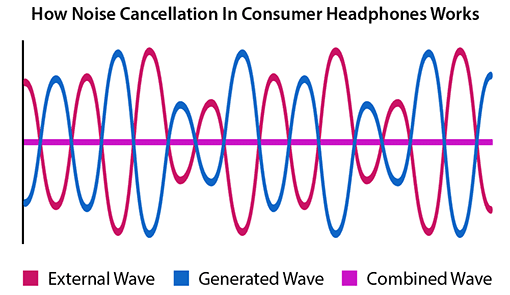
These counter-waves are especially good for erasing consistent sounds, like hums from air conditioning machines – for example – but it’s not that good in terms of “background talk”, because it has to be a very standard “hum” or “hiss” noise.
The best technology – in terms of noise cancellation for contact centres – is special noise-cancellation microphones, which are stored within the headset’s mouthpiece or its “boom arm”.
After all, the goal is for the customer to hear nothing apart from the voice of the agent. So, we want to get a good microphone right in front of the user’s mouth, while having the advanced techniques and digital algorithms to get rid of everything that isn’t the voice of the user.
3. Install White Noise Machines
Installing white noise machines is an effective way to mask background noise in contact centres, helping create a more productive work environment.
White noise machines produce a consistent sound that covers up disruptive noises, making it easier for advisors to concentrate.
These machines produce a consistent sound that covers up disruptive noises, making it easier for advisors to concentrate. Ideally, place them in busy areas or near workstations where noise tends to be more disruptive.
When selecting a white noise machine, choose models that allow you to adjust sound levels based on the specific needs of your space. Educating staff on how these machines work and encouraging feedback can help in fine-tuning their effectiveness.
4. Implement Acoustic Ceiling Tiles
Implementing acoustic ceiling tiles is a practical solution for reducing background noise in contact centres, especially in noisy areas. These tiles are designed to absorb sound waves, minimizing echo and enhancing overall sound quality.
When installing them, focus on areas with high ceilings or where noise tends to bounce around the most. There are various types of tiles available, each targeting specific sound issues and improving the acoustics of your space.
It’s essential to train staff on how to manage noise effectively, helping them understand the role of these tiles in creating a quieter environment.
5. Angle Desks
Angling desks in a contact centre is a simple yet effective way to reduce background noise and increase employee privacy.
Angling desks in a contact centre is a simple yet effective way to reduce background noise
Positioning desks so that advisors don’t face each other minimizes sound interference from conversations, allowing employees to concentrate better on their calls.
Review the current layout to identify spots where desks can be angled for improved sound management.
Getting employee feedback on desk arrangements can enhance comfort and effectiveness in communication. Additionally, consider incorporating privacy panels or barriers to further reduce distractions.
6. Experiment with “Resorb” Panels
Experimenting with “resorb” panels can be a highly effective method for reducing noise levels in contact centres.
These panels are designed to absorb sound waves, which significantly minimizes echo and creates a quieter workspace for employees.
To achieve the best results, place them in areas where noise is a major concern, such as near workstations or common areas.
Resorb panels come in various colours and designs, which can also enhance the aesthetic appeal of the office. Regularly asking staff about noise levels will help assess whether changes are effective.
7. Fill Up Your Walls With Your Advisors’ Art
You can add special panels, with fabric covers, to help absorb noise in the contact centre. But there is no reason for them to be drab.
If you know that certain advisors like art and design, why not task them with decorating these big fabric covers? Your advisors will appreciate the chance to exercise their hobbies at work.
8. Install Soft Furnishings
We’re not just talking about walls and desk screens here. There are other small things that you can do to help muffle and reduce background noise in a call.
Sound can bounce around busy, open-plan spaces. But if you fit padded chairs, blinds or curtains, and thick carpets, you can go the extra mile in your efforts to quieten the contact centre.
9. Place Low Barriers Between Advisors
Desk barriers can be ugly. They can add to the negative stereotypes of the contact centre. They can even damage morale by making advisors feel boxed-in. But they do work in reducing background noise.
So there may be a balance to be struck. You can place low barriers that partially block the noise and don’t hinder advisors from talking to one another.
10. Encourage Advisors to Talk to One Another in Quiet Spaces
It is natural for advisors just to wander over to the person that they want to talk to and hold a discussion. But this could influence the quality of a phone call nearby.
So, in induction training, make a point to hold those discussions in a quiet space. If it still becomes a problem, listen to call recordings with advisors and nicely show them how loud they can be.
11. Hang Sound Diffusers up Around the Contact Centre
Way back in 2016, we visited the General Motors (GM) contact centre in Luton and we spotted the ceiling hanger in the photo below.
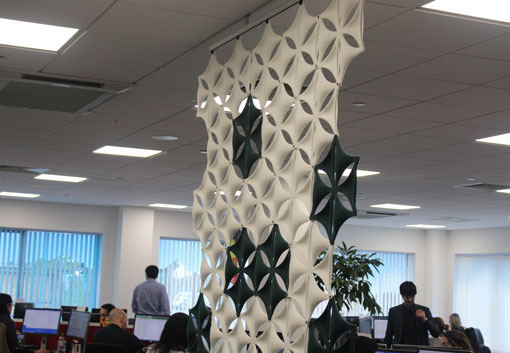
These are called “sound diffusers” and help to absorb soundwaves to reduce background noise on the contact centre floor. They also are decorative and can help to tie in colour schemes.
For more ideas like this, but this time suggested by our readers, read our article: 20 Ways to Reduce Background Noise in the Contact Centre
Testing Noise Levels in a Traditional Contact Centre
While noise-cancellation headsets, with special noise-cancelling microphones in the mouthpiece, can be great at reducing background noise for the customer – there is still the issue of background noise distracting advisors. This is a key consideration if you plan to move back to a traditional brick-and-mortar contact centre.
Why? Because before you rush into deploying other strategies to reduce contact centre background noise, it is good to first test to see just how bad the problem is.
Of course you can do this the conventional way and bring in consultants with big noise machine and microphones, who walk around contact centres and pick out the noisy areas. But many headsets now have the ability to feed the noise levels back to central command.
Before you rush into deploying other strategies to reduce contact centre background noise, it is good to first test to see just how bad the problem is.
You can measure noise levels on an agent-by-agent basis with these headsets and the IT manager can monitor the noise around every agent, in order to see who is having the biggest problem with noise and make a real-time change.
For instance, if there is a lot of noise around, you can turn up the side tone on a particular agent’s headset, so that they don’t have to shout if an unexpected noise disrupts one part of the contact centre. We can also reroute calls to remove this noise disruption.
The results of your background noise tests might show you that you have a significant background noise problem in certain areas of your contact centre.
Final Thoughts
Background noise is still a problem in almost two-thirds of contact centres.
The obvious solution is to invest in noise-cancelling headsets. But many of these headsets only work effectively for consistent humming or hissing noise. Look instead for models with microphones in the mouthpiece or boom arm.
But that’s not the only solution. Remember the ABCs of acoustics and how you can apply ceiling tiles, white noise machines and other design techniques to absorb, block and cover background noise.
Many contact centres now work from home. Quick tips like giving notes to delivery drivers, moving their desks and talking to housemates may be all the advice they need!
For more on the topic of reducing background noise and contact centre headsets, read our articles:
- 12 Quick Ways to Deal With Call Centre Noise
- How Do I… Improve Sound Quality in the Contact Centre?
- What to Look for When Buying Headsets
Author: Charlie Mitchell
Reviewed by: Jonty Pearce
Published On: 25th Nov 2020 - Last modified: 4th Oct 2024
Read more about - Call Centre Management, Headsets







